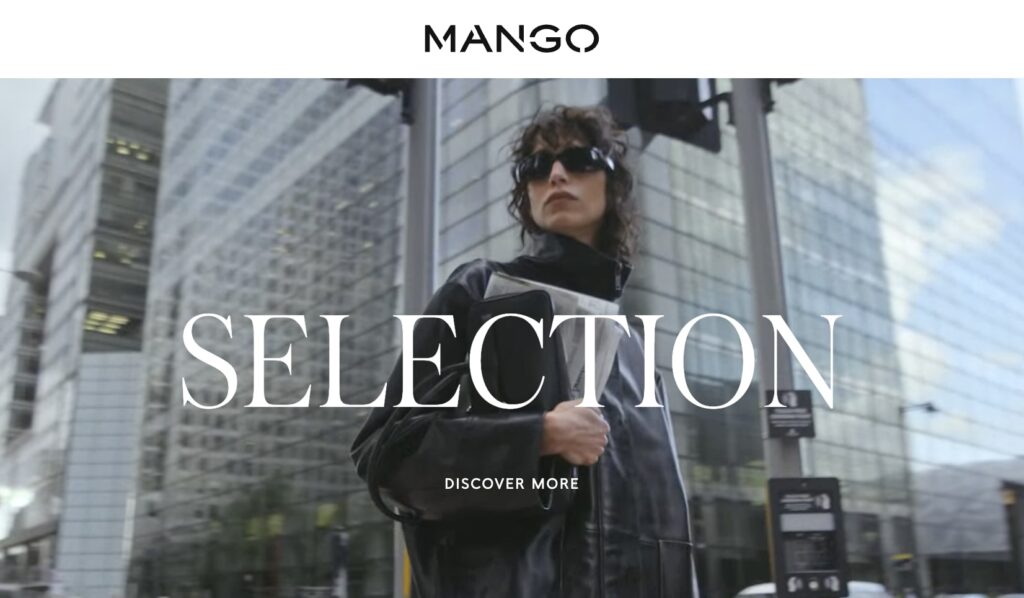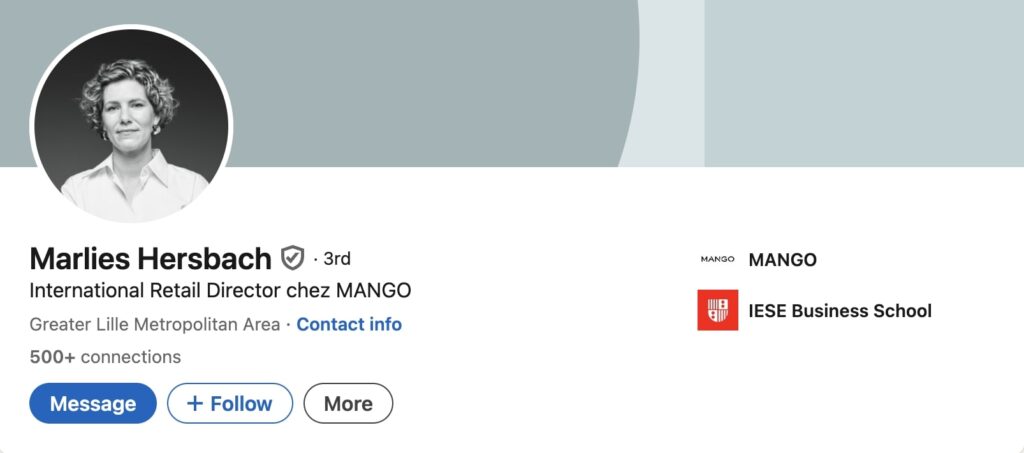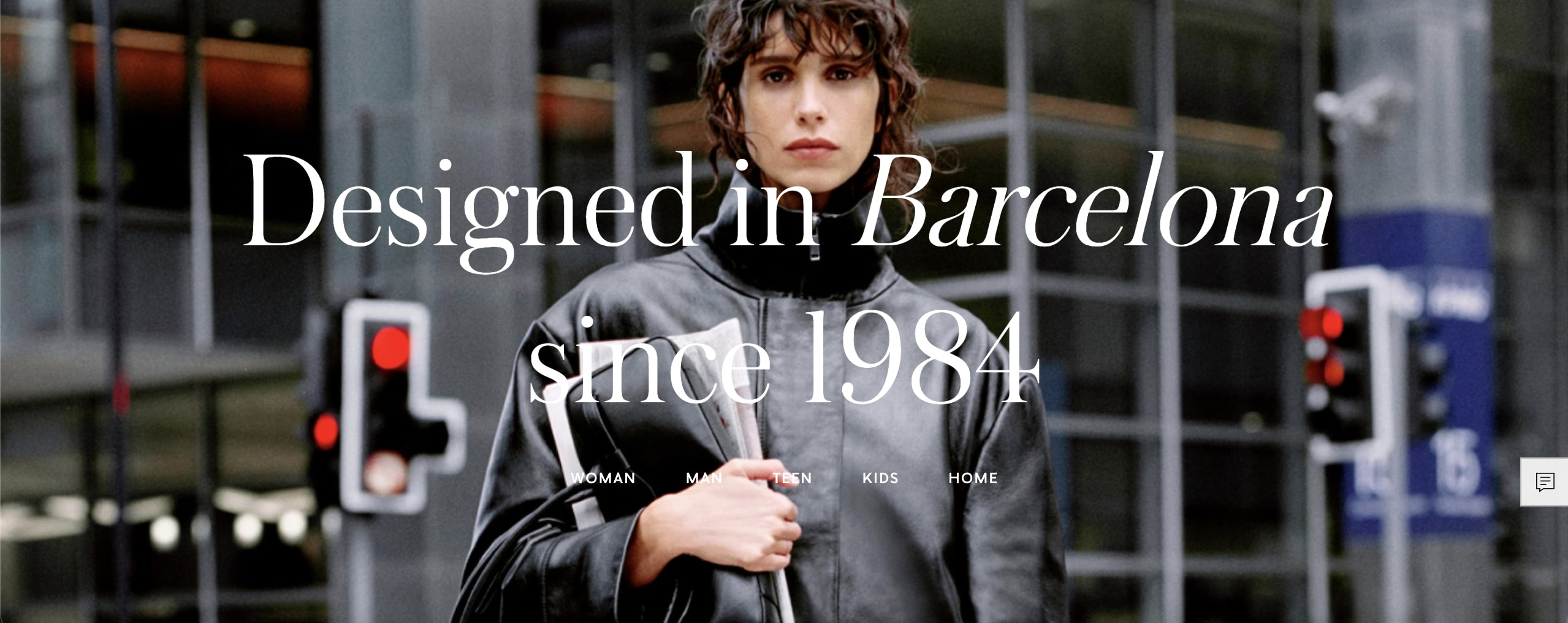- Mango eCommerce is expanding its business by breaking into 12 new regions. With this expansion, it now has a stronger online presence in over 120 markets worldwide. In 2023, the company’s revenue from e-commerce exceeded €1 billion, which is 33% of its overall revenue.
- Mango named Marlies Hersbach as the new Executive Director of E-commerce to oversee this expansion. Hersbach, who has worked for firms like Kiabi and Pimkie in the past, provides a wealth of knowledge in the fashion and retail sectors. Her contribution is essential to the company’s 2024–2026 Strategic Plan, which targets €4 billion in revenue.
- This growth is significant for the fashion retail sector because it shows how important dropshipping and e-commerce are becoming for expanding into new international markets. Mango’s increased online accessibility puts it in a better position to capitalize on new e-commerce trends, boost its competitiveness internationally, and appeal to consumers who are tech-savvy.
Mango’s Digital Transformation Journey

Mango started its digital transformation journey in the late 1990s, and since then, it has made a number of important strategic choices that have confirmed its standing as the industry leader in e-commerce for the fashion sector.
Early Digital Transition
In 1996, Mango established its initial website, which served as the foundation for its online presence. In the fashion sector, this was a pioneering move that came before many of its rivals.
2000 people saw the opening of Mango’s online store, which made it one of the first European fashion firms to adopt digital retail.
Key E-Commerce Growth Milestones
2013 saw Mango launch its first mobile app in response to the increasing number of mobile shoppers, demonstrating early recognition of the significance of mobile commerce.
2016 saw a major redesign of Mango’s digital platform as the company embraced a multi-channel strategy that combined in-store and online buying. Customers could pick up their online orders at actual stores using the “Click & Collect” method, which offered flexibility and convenience.
2020 The COVID-19 Boom’s aftermath: The epidemic pushed Mango’s transition to digital.
Online shopping saw a sharp increase for Mango as physical stores closed all around the world. Its e-commerce revenue increased dramatically, reaching €1 billion in 2023 and contributing 33% of the overall income.
Strategic Decisions Driving E-Commerce Success
Mango’s e-commerce success can be linked in large part to its presence in overseas markets. Its consumer base was expanded by its strategic use of internet platforms to enter new markets including the United States and Northern Europe. In order to keep up with the rising demand, Mango also improved the efficiency and speed of its deliveries.
Technology & Data-Driven Infrastructure
To improve user experience and product suggestions, Mango has made investments in cutting-edge technologies like artificial intelligence and data analytics. Personalization is made possible by these techniques, which are essential for keeping digital customers.
Current E-Commerce Infrastructure
With a strong internet presence available in 25 languages, Mango’s digital operations currently operate in more than 120 countries. The primary objectives of their 2024–2026 Strategic Plan are to increase technological capacity and generate €4 billion in income by 2026.
The organization is utilizing AI, data management, and a strong shipping system to maintain operational excellence.
Mango has become a major force in the fashion e-commerce industry because of its steady investment in digital channels and strategic choices including tech adoption and geographic development.
Meet the New Executive Director: Leadership in Focus

Marlies Hersbach has been appointed by Mango as the new Executive Director of E-commerce, marking a significant leadership change as the company looks to expand into 12 additional markets with its online presence.
Hersbach has held several senior e-commerce positions at companies including Kiabi and Pimkie, offering her a wealth of knowledge in the fashion retail sector. She was crucial in managing Mango’s store strategy in this important European market before joining the firm in 2022 as International Retail Director for France.
Experience and History
With a focus on increasing online growth, Hersbach has a strong history in both retail and digital strategy. She graduated from the University of Utrecht with a degree in French Language and Culture with a focus on Intercultural Communication.
Her ability to manage all aspects of in-store retail operations while keeping up with the rapidly changing digital world makes her the perfect leader for Mango’s e-commerce business.
Aligning with Mango’s Ambitions
Hersbach’s background fits in perfectly with Mango’s plan to break into 12 new countries, including those in Oceania, Southeast Asia, and Africa. Her experience navigating global retail markets, especially from her work in France, puts her in a good position to lead Mango’s e-commerce expansion.
Given her demonstrated experience in digital sales and logistics management, it is expected that she will lead Mango’s online channel, which already generates a noteworthy 33% of the company’s overall revenue, to even greater heights.
Vision and Future Growth
Hersbach will be responsible for carrying out Mango’s 2024–2026 Strategic Plan, which seeks to raise overall sales to €4 billion by 2026. She will report directly to Elena Carasso, Mango’s Online and Customer Director. This plan places a strong emphasis on operational effectiveness, technical innovation, and leveraging data-driven insights to improve the online consumer experience.
Comparing Hersbach to Her Predecessors and Competitors
Hersbach stands out from her predecessors due to her extensive background in both online and brick-and-mortar commerce. Mango has developed a tech-driven web infrastructure more strategically and earlier than other of its fast-fashion rivals, such as Zara and H&M.
Executives from these firms who are also quickly adjusting to the post-pandemic spike in online buying are in direct rivalry with Hersbach due to her leadership during this era of Mango’s digital transition.
Mango’s e-commerce operations will advance under Hersbach’s leadership because of the unusual combination of retail and digital experience, especially as the company grows into new foreign markets and strengthens its online presence.
Founder’s Backstory: The Roots of Mango
Now, let’s find out how it all started. How this e-commerce giant began and what the founder had to go through in order to reach such heights.
The Beginnings of Mango: The Entrepreneurial Path

Turkish-Spanish businessman Isak Andic and his brother Nahman Andic established Mango in Barcelona in 1984. The Andic brothers moved to Spain from Turkey, where they started their business selling Asian imported clothes.
Selling shirts out of a tiny store in Barcelona was their initial step into retail, serving as a starting point for the ultimate founding of Mango.
Isak Andic wanted to meet the growing need in Spain for fashionable yet reasonably priced apparel by providing high-quality, trendy fashion at reasonable costs. The founder’s aspirations to become a global businessman were reflected in the name of the company, Mango, which was selected to imply exoticism and appeal to buyers worldwide.
Important Strategic Changes and Pivots
Mango’s history has been shaped by a number of pivots that correspond with important e-commerce and brand-building tactics:
Mango’s early international expansion was into foreign markets. Mango has outlets in London and Paris by the early 1990s. The choice to expand globally laid the groundwork for the success of e-commerce in the future. Mango is currently available in more than 120 markets.
Taking Up E-Commerce Early
Mango’s early use of internet retail was one of its most important strategic turns. The business introduced its e-commerce platform in 2000, setting the standard for online fashion selling a decade ahead of several rivals.
Years later, as internet shopping took off, especially after COVID, the corporation was able to benefit from this audacious action as online sales soared.
Technological Investment
As the world went digital, the founder’s vision changed. Mango made significant technological investments to develop a data-driven e-commerce platform that improves the user experience.
Mango has been able to maintain its competitiveness in the growingly tech-focused retail industry because of technologies like AI for personalization and real-time data analytics.
Expansion into 12 New Markets: What It Means for the Industry
Mango has reached a major milestone in its international growth strategy with its recent decision to extend its online presence into 12 additional regions, which include nations in Africa, Southeast Asia, and Oceania. Angola, Belize, Brunei, Equatorial Guinea, Gabon, Gambia, Honduras, Laos, Mongolia, New Zealand, Papua New Guinea, and Togo.
These markets include a varied blend of developing economies with expanding e-commerce possibilities, especially in Southeast Asia and Africa where internet usage is increasing.
Why Were These Markets Chosen?
Growing middle classes, more internet penetration, and expanding smartphone usage are present in many of these nations, particularly those in Africa and Southeast Asia. For instance, faster digitalization is occurring in places like Gabon and Angola, which attracts companies seeking to reach new markets.
Decreased Competition in Developing Markets
Global fashion behemoths like Zara and H&M tend to provide less of a threat in these areas than in more developed markets like Europe and North America. Mango’s calculated move into these markets enables it to gain traction quickly and cultivate a devoted following before rivals do the same.
Geographic Diversification
Mango reduces its reliance on its long-standing strongholds in Europe and North America and diversifies its revenue sources by entering these new markets. This geographical spread is essential for reducing the hazards associated with localized economic downturns or oversaturation.
The Competitive Environment in New Regions
In various markets, there are varying levels of competition. Global fast fashion businesses are gradually making their way into Africa and Southeast Asia, where local firms currently hold a dominant position.
In some of these markets, Mango’s primary rivals, including H&M, Zara, and Uniqlo, have started to enter the e-commerce arena. Nonetheless, Mango’s early entry may provide it an advantage in terms of market share and brand recognition.
Furthermore, a lot of these areas depend on imported clothing, thus Mango’s well-established web presence and logistics allow the business to offer a quick and easy buying experience.
However, Mango has organizational and infrastructure issues, especially in nations like Equatorial Guinea and Papua New Guinea, which have less developed e-commerce infrastructures.
To overcome these obstacles, substantial investments in order fulfillment and customer support as well as strong relationships with regional delivery companies would be needed.
Consequences for Worldwide Fashion E-Commerce Prospects
With Mango’s entry into these 12 markets, international fashion firms have an increasing opportunity to profit from e-commerce in developing nations.
Following the COVID-19 pandemic, there has been a notable surge in the use of digital retail, offering substantial prospects for firms who are prepared to tackle the logistical challenges associated with less developed regions.
Mango’s early entry into these markets could put it in a leading position once these areas’ e-commerce infrastructure improves.
Impact on the Worldwide Supply Chain
Mango will need to optimize its worldwide supply chain as it grows into more geographically diverse locations in order to meet the increasing demand in areas with different logistical problems.
Changes in the mechanics of transportation may result from this expansion, with a focus on improved warehousing, quicker cross-border delivery, and more effective customs clearance.
Mango’s approach to handling these complications is something that dropshippers and other e-commerce firms should observe, as it provides valuable insights into expanding worldwide without sacrificing cost-effectiveness.
Similar to Other Fashion Firms
Although frequently in better-developed e-commerce areas, other fashion firms like ASOS and Zara have also concentrated on expanding internationally online.
Mango’s strategy is different in that it concentrates on developing markets, which offers it the benefit of forging a solid presence in areas with significant development potential before they get congested. Mango is probably going to investigate this in order to improve delivery effectiveness and customer satisfaction.
Companies such as H&M have also made investments in local partnerships in order to overcome logistical issues in these regions.
Lessons for E-commerce Entrepreneurs and Dropshippers
What can someone who is just starting this journey learn from Mango’s experiences? Let’s find out:
Early Digital Channel Adoption
The value of early adoption is among the most important lessons to be learned from Mango’s past. Mango was ideally positioned to profit from the explosion of internet shopping since it introduced an e-commerce platform early.
In order to keep ahead of trends, entrepreneurs today can take a lesson from this and quickly adopt new technologies.
Global Market Expansion
The founders of Mango used global markets to drive their company’s expansion. This illustrates a fundamental tactic for expanding companies worldwide. Investigating new markets can help dropshipping business owners expand without investing a large amount of money in physical infrastructure.
Mango was able to adjust to shifting consumer behavior while upholding a consistent brand image over the course of its existence. In a market that is changing quickly, maintaining long-term brand loyalty requires striking a balance between continuity and adaptation.
Other Activities & Contributions
In addition to heading Mango, Isak Andic has invested in real estate and was once a candidate for a senior role at Inditex, the organization that owns Zara. He has expanded his commercial holdings throughout the years and is still among Spain’s wealthiest people.
In conclusion, the story of Isak Andic, the creator of Mango, who started out by selling imported clothing before building a global fashion empire, serves as an example of the strength of foresight, creative thinking, and global growth.
Mango’s experience serves as a reminder to prospective e-commerce entrepreneurs of the value of embracing digital opportunities, strategically scaling, and remaining flexible in a changing industry.
Logistical Optimization
Mango’s expertise in streamlining supply chains will prove beneficial for business owners seeking to expand globally, particularly as it expands into areas with diverse logistical challenges.
It will be crucial to comprehend the complex nature of cross-border logistics, warehousing, and local delivery in order to preserve customer satisfaction while controlling costs.
Adaptability to Local Markets
Mango’s capacity to customize its products to suit regional preferences and logistical needs highlights how crucial market localization is. When growing their firms internationally, entrepreneurs should take local market preferences, infrastructure constraints, and regulatory frameworks into account.
In conclusion, Mango’s entry into several additional markets underscores the prospects and difficulties present in the international e-commerce fashion sector.
Effective logistics, local partnerships, and the capacity to take advantage of the expanding digital demand in these developing areas will probably be key factors in its success. Mango’s approach provides e-commerce and dropshipping companies with a road map for expanding internationally while overcoming competitive and logistical challenges.
Mango’s Strategic Use of Technology in E-commerce
Mango has strategically embraced advanced e-commerce technologies to optimize its operations and deliver a seamless customer experience across its global markets.
The company has focused on creating an efficient digital infrastructure that supports everything from website functionality and payment gateways to logistics, personalization, and customer engagement.
Platform for E-Commerce and Website Infrastructure
Mango uses a specially developed e-commerce platform to manage its extensive international activities. The website facilitates transactions across more than 120 countries and is accessible in more than 25 languages. Through the use of responsive web design, the platform guarantees a seamless user experience across PCs, tablets, and mobile phones.
Mango’s platform provides localized payment solutions through integrations with top payment providers. Depending on the market, they include choices like PayPal, Visa, Mastercard, and regional payment methods, making it simple for clients to finish transactions in their chosen currency and form of payment.
Learn more: See what tools other e-commerce brands are using.
Supply Chain Optimization and Logistics
Deliveries across a wide range of markets in a timely and effective manner is one of Mango’s primary priorities.
The business has made investments in logistical alliances with international and local couriers in order to do this. They shorten shipment delays and accelerate the distribution process by partnering with third-party logistics (3PL) providers and using real-time inventory management.
Mango also provides a “Click & Collect” service that maximizes interactions between e-commerce and retail channels by enabling users to pick up their online orders from physical locations.
This omnichannel approach works especially well in markets where logistics can be difficult since it gives customers a variety of delivery choices.
The Use of Artificial Intelligence (AI) and Data Analytics
Mango optimizes its operations and improves client experiences via AI and advanced data analytics. The company customizes its product suggestions and marketing campaigns by examining client behavior, past purchases, and browsing habits.
This allows Mango to make offers that are specific to each customer’s tastes. Increased conversion rates and client retention have been directly attributed to the application of AI-driven customization.
AI-Powered Search and Recommendations
Mango’s AI system enhances its e-commerce platform’s search capability, facilitating customers’ discovery of the goods they desire. To improve the purchasing experience, it also provides tailored product recommendations based on a user’s browsing history and preferences.
Automation of Customer Service
Mango has combined chatbots and automated features for customer service to address routine questions, offering round-the-clock assistance and lightening the workload for human agents. These instruments aid in streamlining processes and enhancing reaction times.
Exclusive and Distinctive Technologies
The brand has created in-house technologies to handle its huge inventory and guarantee seamless operations throughout several nations. The organization can optimize everything from production schedules to last-mile delivery by monitoring product flow from production to delivery thanks to its end-to-end digital supply chain technology.
Their real-time stock management system, which gives clients precise updates on product availability, is a noteworthy element. This system is essential for keeping track of inventory in more than 120 nations and guaranteeing that goods are shipped from the most productive warehouse.
Collaborations with IT Vendors
In order to improve its digital infrastructure, Mango has partnered with top technology companies. For instance, it works with Oracle to provide cloud-based ERP systems that make it possible to manage operations, supply chains, and finances effectively across international marketplaces. Through this collaboration, Mango’s systems are guaranteed to be scalable and capable of managing the growing intricacy of global operations.
Mango also incorporates local couriers and top logistics companies like DHL to guarantee prompt and effective delivery everywhere. This partnership enables the business to provide customers with quicker shipping choices and increased delivery process transparency.
Effect on Online Sales
Mango’s online sales have increased significantly as a result of employing technology to streamline front-end and back-end operations. Mango’s e-commerce revenue exceeded €1 billion in 2023, making up 33% of the group’s overall revenue.
The business’s technological investments have made it one of the most technologically sophisticated fashion retailers, and its capacity to provide a flawless cross-channel buying experience offers it a competitive advantage in the fiercely competitive e-commerce market.
In summary, Mango’s e-commerce success may be attributed in large part to its strategic use of technology.
The company is able to offer a smooth, customized shopping experience to clients all over the world because of its investments in AI, data analytics, logistics, and collaborations with IT suppliers.
These tactics provide insightful information for e-commerce companies hoping to grow internationally without sacrificing operational effectiveness.
Mango’s Future Vision: E-Commerce Expansion and Beyond
Mango’s short and long-term goals in e-commerce reflect a continued push toward global growth, sustainability, and technological innovation. With a firm focus on expanding its digital footprint, Mango aims to maintain its competitive edge in an increasingly saturated fashion retail market.
Target Years
From 2024 to 2026, Mango’s immediate goal is to raise overall revenues to €4 billion by 2026, with a sizable portion coming from e-commerce. At the moment, e-commerce accounts for about 33% of overall sales, but Mango anticipates that as it continues to expand into new countries, this percentage will rise.
The company has expanded into 12 new markets in recent times, including those in Southeast Asia, Africa, and Oceania, opening doors for further expansion into underserved areas. With growing digital penetration and potential consumer bases in emerging markets, the objective is to bolster its online presence.
Sustainability Initiatives
Mango has made a commitment to include sustainable fashion at the center of its long-term plans.
The company has launched steps to make its entire e-commerce and supply chain activities more environmentally friendly. For instance, by 2025, it wants to utilize only sustainable cotton and lower carbon emissions throughout its logistics system.
Mango can attract an increasing number of environmentally conscious customers by incorporating sustainable practices across both its digital and physical channels.
Technological Innovations
Mango is currently concentrating on improving its digital infrastructure by utilizing automation, data analytics, and artificial intelligence. Improving the customer experience is the company’s latest focus on predictive analytics and AI-powered personalization. Mango also intends to enhance order fulfillment effectiveness and delivery times by investing in automation and warehouse robotics to optimize logistics.
Long-Term Vision: Digital Fashion Dominance Worldwide

Over the long term, Mango intends to be one of the top global fashion shops, competing with heavyweights like Zara and H&M. Mango’s ecommerce 2024–2026 Strategic Plan calls for it to keep growing in important foreign markets, with a particular emphasis on underdeveloped areas with significant room for expansion.
The company aims to become the industry leader in online fashion by strengthening its e-commerce infrastructure and growing quickly.
Mango’s long-term plan places a strong emphasis on an omnichannel approach. The company intends to increase its mobile purchasing capabilities and use services like Click & Collect to easily combine its e-commerce platform with its physical stores.
They will have a competitive advantage because of this hybrid approach, which will satisfy consumers who prefer to purchase both online and offline.
Mango intends to maintain its position as a market leader by utilizing sustainability as a crucial difference. The business is funding efforts related to circular fashion, including recycling programs and the introduction of more environmentally friendly product lines. Mango may eventually take the lead in the sustainable fashion movement thanks to its dedication to sustainability, which will give it a distinct competitive advantage.
Global Fashion and E-Commerce Trends Affecting Mango’s Approach
Here are some important trends that are affecting the company’s plans and strategies.
Digital-First Customers
With more customers choosing online shopping, Mango is probably going to concentrate on improving mobile-first platforms. Opportunities and challenges arise from the global shift to mobile commerce, especially in markets with different levels of digital infrastructure.
Post-Epidemic Boom in E-Commerce
The epidemic accelerated the transition to online shopping, and there are no indications that this trend will decrease. The growth in online purchasing poses both an opportunity and a concern, as Mango competes in an increasingly saturated market where other fashion brands are also developing their online operations.
Sustainability Trends
Consumer purchasing behavior is being impacted by the worldwide emphasis on sustainability, especially in the fashion sector. Mango’s endeavors to establish environmentally sustainable supply chains and adopt sustainable practices are in line with a wider industry movement toward ethical manufacturing and consumption.
Conclusion: Key Takeaways for E-commerce Enthusiasts
Under the direction of a new executive team, Mango’s e-commerce strategy is a model of combining technology, logistics, and sustainability to expand a worldwide brand.
Mango’s path offers insightful information for everybody involved in e-commerce, from entering 12 new markets to adopting AI-powered personalization and sustainable practices.
Important Lessons Learned:
- Tech-Driven Growth: Mango demonstrates how technology can improve consumer experiences and streamline operations through the use of AI, data analytics, and automated logistics. Smaller companies ought to consider using these tools, even on a tight budget.
- Global Market Expansion: Mango’s calculated foray into unexplored areas highlights the value of geographic diversity. It draws attention to the potential dropshipping opportunities in emerging economies with expanding e-commerce markets.
- Sustainability as a Differentiator: Mango’s dedication to sustainability provides a model for creating a brand that appeals to environmentally sensitive customers. It is advisable for entrepreneurs to investigate methods of incorporating sustainable practices into their own businesses.
The Founder of Mango’s Lessons for Entrepreneurs
Isak Andic, the founder of Mango, shares a plethora of knowledge with aspiring business owners based on his decades-long experience creating a successful worldwide fashion brand. His path from a modest family business to one of the most well-known fashion businesses in the world teaches important lessons about invention, resilience, and flexibility.
Resilience in the Face of Difficulties: Andic encountered some difficulties on his entrepreneurial path. Through perseverance and a modest storefront selling imported clothing from Asia, he gradually transformed Mango into a well-known worldwide brand. Remaining resilient in the face of seemingly sluggish growth is a crucial lesson. During economic downturns, Andic modified Mango’s business strategy, stressing the value of persevering through challenges and picking up lessons from failures.
Flexibility in the Market: Mango changed along with customer trends. Mango was able to prosper in e-commerce thanks to Andic’s vision in adjusting to the move toward digital retail, particularly after COVID-19. The ability to adapt to change and stay ahead of industry trends is a skill that entrepreneurs should have. This includes the ability to enter new markets, adopt new technologies, and modify business plans in response to changing customer needs.
Innovation as a Growth Engine: Mango’s expansion has been mostly driven by innovation. Andic’s strategy emphasizes the value of ongoing innovation by investing in AI-driven consumer experiences and developing novel supply chain models. Entrepreneurs should take note: maintaining relevance calls for both excellent ideas and a never-ending desire to get better.
Global Perspective: One of Mango’s primary growth tactics was its international expansion. Andic realized early on that growing the company required having a worldwide perspective. This requires business owners to look beyond their local markets and analyze how their goods and services could fit into a larger global picture.
Advice for Entrepreneurs:
- Be resilient and learn from setbacks.
- Adapt to change by embracing technology and evolving consumer preferences.
- Innovate constantly to remain competitive in an ever-changing market.
- Think globally and expand with an international perspective.
Mango’s growth story is a powerful example of how combining these principles can lead to long-term success. Entrepreneurs can apply these lessons in their own journeys, whether in fashion, e-commerce, or any industry that values resilience and innovation.
Read our most recent articles on DS Weekly for more detailed tactics on international brand expansions and e-commerce breakthroughs! Find out how businesses like Mango are changing the fashion industry and how you can use this knowledge for your own online businesses.

Leave a Reply